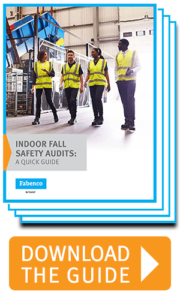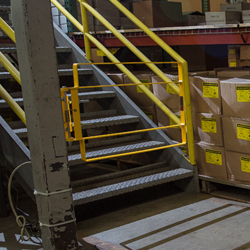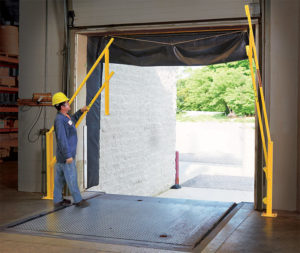
If your facility is one of the thousands across the country shut down by the COVID-19 pandemic, you’re probably ticking the minutes away, counting dollars lost, and considering ways to remain productive. There’s no denying that the pandemic is impacting every level of business operations. If there’s any silver lining, it’s that you’ve got a moment to reassess things that usually don’t take priority, like your facility’s indoor fall protection.
According to the National Safety Council, OSHA’s Fall Protection-General Requirements have been the most frequently cited violation for nine years running. Safety managers should jump on the chance to examine their current indoor fall protection protocols, communication, and each piece of equipment from your guardrails, mezzanine gates and industrial swing gates, right down to your last fall protection harness. Let’s walk through what you need to know to use this time wisely.
Understand OSHA Fall Protection Regulations
Because falls result in the most common workplace injuries, OSHA takes fall protection seriously and frequently updates its guidelines. That’s why it’s beneficial to review your indoor fall protection regularly, and/or consult with a specialist who keeps up on changing OSHA regulations.
Though regulations vary by industry, most commercial and industrial facilities must provide fall safeguards at any location where workers could fall from a height of 4 feet or more, or if they could fall into dangerous production equipment. Such areas include stairways, mezzanines, elevated workstations or holes in the floor workers could fall through. Loading docks have some exceptions, though more companies are finding the use of industrial swing gates are beneficial as nearly a quarter of falls happen on loading docks.
OSHA also outlines circumstances where workers need to use personal equipment for safety, such as a fall protection harness or a safety line. These instances should be worked into your company’s fall safety guidelines and training programs.
Identify Your Greatest Areas of Concern
After reviewing the guidelines, plan a walking tour of your facility with key staff members and possibly an OSHA inspector or a safety consultant. You might find this handy six-point checklist helpful. The main focal points of your tour should be:
- Stairways: First, check the condition of your stairways. Are they structurally sound? Are stair treads missing or damaged? Are items stored on or near the stairs that could cause workers to trip? Do they have the appropriate handrails (right height and rated to 200 pounds)? Does a self-closing swing gate guard the top of the stairs?
- Mezzanines: As companies take advantage of the ability to grow up, rather than grow out, mezzanines have become a common area for industrial facilities to store extra materials. These present extra risks for employees. Are your mezzanines structurally sound? Do all mezzanines have proper handrails or mezzanine gates? Are weight limits posted and observed? Are mezzanine gates located in proper positions? Is necessary personal safety equipment available for workers who load and unload materials from mezzanines?
- Doorways and Walkways: It may seem basic but keeping doorways and walkways clear of trip hazards is imperative. Do ladders frequently block doorways? Do extension cords, hoses or other tripping hazards bisect doorways and walkways?
Loading Docks: As we mentioned before, OSHA offers exceptions on the requirements for handrails or guardrails along loading docks if they impede the unloading of vehicles. But, because of the frequency of injuries on loading docks and the tendency to leave loading dock doors open to improve ventilation in industrial plants, you might want to seriously reconsider these risks. Can you safely place industrial swing gates on the dock and still leave room for trucks to unload? Can you limit the area where trucks unload and place guard rails in other locations? Are stairs protected with self-closing gates?
- Other Areas: Are there other, smaller areas of concern around your industrial plant? Are there holes through the floor or smaller ladder systems that require extra protection? Are there skylights or vent systems in the roof? Do drainage systems require any extra attention? Are there areas of heavy forklift traffic that could be better protected?
Address Personal Safety Equipment and Training
Now is also a great time to check on your personal safety equipment and training programs and materials.
Review the condition of your personal fall protection equipment. Do your harnesses meet the latest OSHA standards? Is each fall protection harness in good condition, with no tears or severely worn areas? Do lifelines also meet current standards? Are they in proper working condition, free of frayed lines, and clear of sharp edges that can damage lines?
Now is also the best time for your leadership teams to review your safety training materials and methods. Are materials current with OSHA regulations? Do materials reflect the current activities in the plant? Are all storage locations and systems included in the training materials? Are training materials written in language understandable by your current and potential future workforce? Are training programs meeting the safety needs of your employees? Is training required and updated as operations change? Will you need to consider COVID-19 and social distancing training in the time period your plant is reopening?

Your company is weathering a great deal of concerns during the coronavirus pandemic, but the downtime also creates the opportunity to ensure your plant will be ready to get up and running safely when it is clear for your employees to return. Fabenco would be happy to lend our expertise to this endeavor as you strive to meet and exceed OSHA expectations for your fall protection program.







